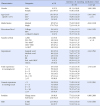Abstract
Purpose
This study was aimed to identify the mediating and moderating effects of safety-specific transformational leadership on the relationship between barrier to and intention of reporting medication errors.
Methods
Two hundred thirty seven nurses from seven different hospitals participated in the study. Safety-specific transformational leadership was measured by an instrument with 10 items, barrier to reporting medication errors with 16 items, and intention of reporting medication errors with 3 items. The data was collected from September to October 2012. Descriptive statistics, factor analysis, t-test, ANOVA, Pearson correlation coefficient and a hierarchial regression analysis were used.
Results
There were significant negative correlations between the subcategories of barrier to reporting medication errors and intention of reporting medication errors (r=-.16~-.27, p<.001), and a positive correlation between the intention and safety-specific transformational leadership (r=.25, p<001). Transformational leadership was a mediator between barrier to and intention of reporting medication errors.
Figures and Tables
Table 1
Summary of Exploratory Factor Analysis of the 16-items Barrier to Reporting Medication Errors

Table 2
Intention of Reporting Medication Errors according to the Participants' Characteristics (N=237)

References
1. Milch CE, Salem DN, Pauker SG, Lundquist TG, Kumar S, Chen J. Voluntary electronic reporting of medical errors and adverse events: an analysis of 92,547 reports from 26 acute care hospitals. J Gen Intern Med. 2006; 21:165–170. DOI: 10.1111/j.1525-1497.2006.00322.x.

2. Kim MS. The effectiveness of error reporting promoting strategy on nurse's attitude, patient safety culture, intention to report and reporting rate. J Korean Acad Nurs. 2010; 40(2):172–181. DOI: 10.4040/jkan.2010.40.2.172.

3. Kim MJ. Effects of safety climate and work environment on barrier tomedication administration errorreporting. [master's thesis]. Busan: Pusan National University;2013.
4. Bodina A, Demarchi A, Castaldi S. A web-based incident reporting system: a two years' experience in an Italian research and teaching hospital. Ann Ig. 2014; 26(3):219–225.
5. Haw C, Stubbs J, Dickens GL. Barriersto the reportingof medication administration errors and near misses: an interview study of nurses at a psychiatric hospital. J Psychiatr Ment Health Nurs. 2014; 21(9):797–805. DOI: 10.1111/jpm.12143.
6. Wakefield BJ, Blegen MA, Uden-Holman T, Vaughn T, Chrischilles E, Wakefield DS. Organizational culture, continuous quality improvement, and medication administration error reporting. Am J Med Qual. 2001; 16(4):128–124.

7. Kim MJ, Kim MS. Canonical correlation between organizational characteristics and barrier to medication error reporting of nurses. J Korea Acad Ind Coop Soc. 2014; 15(2):979–988. DOI: 10.5762/KAIS.2014.15.2.979.

8. Holmström AR, Laaksonen R, Airaksinen M. Howto make medication error reporting systems work-factors associated with their successful development and implementation. Health Policy. 2015; 119(8):1046–1054. DOI: 10.1016/j.healthpol.2015.03.002.
9. Throckmorton T, Etchegaray J. Factors affecting incident reporting by registered nurses: the relationship of perceptions of the environment for reporting errors, knowledge of the nursing practice act, and demographics on intent to report errors. J Perianesth Nurs. 2007; 22(6):400–412.

10. Ajzen I, Madden TJ. Prediction of goal-directed behavior: attitudes, intentions,and perceived behavioral control. J Exp Soc Psychol. 1986; 22(5):453–474.
11. Tabak N, Fleishman S. The intention to report medication error. Med Law. 2011; 30(3):363–382.
12. Williams SD, Phipps DL, Aschcroft D. Examining the attitudes of hospital pharmacists to reporting medication safety incidents using the theory of planned behaviour. Int J Qual Health Care. 2015; 27(4):297–304. DOI: 10.1093/intqhc/mzv044.

13. Kim MS. Role of transformational-leadership in the relationship between medication error management climate and error reporting intention of nurse. Korean J Adult Nurs. 2013; 25(6):633–643. DOI: 10.7475/kjan.2012.24.6.633.

15. Zohar D, Tenne-Gazit O. Transformational leadership and group interaction as climate antecedents: a social network analysis. J Appl Psychol. 2008; 93(4):744–747.

16. McFadden KL, Henagan SC, Gowen CR. The patient safety chain: transformational leadership's effect on patient safety culture, initiatives, and outcomes. J Oper Manag. 2009; 27:390–404.

17. Fernández-Muñiz B, Montes-Peón JM, Vázquez-Ordás CJ. Safety leadership, risk management and safety performance in Spanish firms. Saf Sci. 2014; 70:295–307. DOI: 10.1016/j.ssci.2014.07.010.

18. Barling J, Loughlin C, Kelloway EK. Development and test of a model linking safety-specific transformational leadership and occupational safety. J Appl Psychol. 2002; 87(3):488–496.

19. Na BJ. Nurses' perception of safety climate and barriers to medication administration error reporting in a university hospital. [master's thesis]. Gwangju: Chunnam University;2010.
20. Bass BM, Avolio BJ. MLQ multifactor leadership questionnaire. Redwood City: Mind Garden;2002.
21. Kim MS. Medication error management climate and perception for system use according to construction of medication error prevention system. J Korean Acad Nurs. 2012; 42(4):568–578. DOI: 10.4040/jkan.2012.42.4.568.

22. Kim KS, Kwon SH, Kim JA, Cho SH. Nurses' perceptions of medication errors and their contributing factors in South Korea. J Nurs Manag. 2011; 19:346–353. DOI: 10.1111/j.1365-2834.2011.01249.x.

23. Dovey SM, Phillips RL. What should we report to medical error reporting systems? Qual Saf Health Care. 2004; 13(5):322–323.

24. Heskett J, Jones T, Loveman G, Sasser WE Jr, Schlesinger L. Putting the service-profit chain to work. Harv Bus Rev. 1994; 72(2):164–170.
25. Lukas CV, Holmes SK, Cohen AB, Restuccia J, Cramer IE, Shwartz M, et al. Transformational change in health care systems: an organizational model. Health Care Manage Rev. 2007; 32(4):309–320.
26. Uribe C, Schweikhart S, Pathak D, Dow M, Marsh GB. Perceived barriers to medical-error reporting: an exploratory investigation. J Healthc Manag. 2002; 47:263–279.

27. Judge TA, Bono JE. Five-factor model of personality and transformational leadership. J Appl Psychol. 2000; 85(5):751–765.

28. Kapp EA. The influence of supervisor leadership practices and perceived group safety climate on employee safety performance. Saf Sci. 2012; 50(4):1119–1124. DOI: 10.1016/j.ssci.2011.11.011.





 PDF
PDF ePub
ePub Citation
Citation Print
Print





 XML Download
XML Download